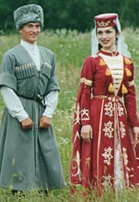|
|
The Cicassian of Syria were once part of a large people group who lived in the northwest Caucasus who often found themselves in war with neighbors. By the mid-1860s nearly ninety percent of the Cicassian population had been either killed or forced to flee. Of those who went to Syria, many lived in one of the five villages in the Golan Heights before being forced to withdraw further into Syria after the 1967 Arab-Israeli war. Many took up residence in the slum districts of Damascus.
And yet many Cicassian have done well economically by working in government, civil service or the military. Most are also multi-lingual, learning Arabic in school, speaking Adygey (their native language) among themselves and studying English. Cultural events are also very important in the Cicassian society. During holidays and weddings they perform folk dances and songs in their traditional dress, which includes long coats and wool hats for the men and embroidered silk dresses for the women.
Historically, the Cicassian were divided into four castes: pshi (princes, who organized the wealth and external relations of the villages), warq (nobles), tifaquat’l (freemen, who were farmers or herdsmen) and pshit’l (slaves, who served the princes and nobles as servants and laborers). Today this caste system only survives as a part of their origin. Within the family structure, the wife has authority over many household matters; however, the husband has the ultimate say in cases of disagreement. Marriages are traditionally based on love and an interest from both the woman and the man. Cicassians typically marry in their early thirties.
Christianity was introduced to the Cicassian between the sixth and twelfth centuries by Byzantine missionaries; however, the Cicassian have been Sunni Muslims for the past several hundred years. The Cicassian are viewed by many Orthodox Eastern Muslims as being very liberal. Today, there is only one missions agency working among the Cicassian. Although the New Testament and the JESUS film are available in their language, there are only a very small number of believers. Pray that the light of the gospel will reach the Cicassian.
For more information on the Cicassian of Syria, visit:
http://kcm.co.kr/bethany_eng/p_code4/146.html
www.joshuaproject.net/countries.php?rog3=SY
www.peoplegroups.org/MapSearch.aspx?country=Syria
(Information compiled from www.joshuaproject.net)
(Note: The website links above are intended to provide you with more information about this people group. Some of the links are to groups that are not religious in nature but who provide information and background that may be helpful in researching this people group. The content of each of the websites linked to is the sole responsibility of the linked-to organization. Views expressed on these websites do not necessarily reflect the opinions and beliefs of the staff or writers of Lausanne World Pulse or those of the Lausanne Committee for World Evangelization, Institute of Strategic Evangelism, Evangelism and Missions Information Service or Intercultural Studies Department.)


